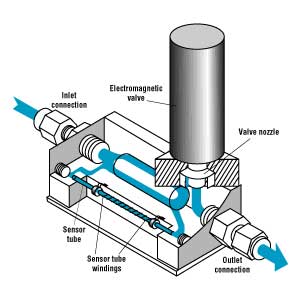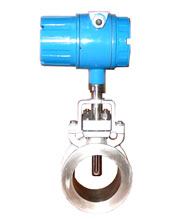Thermal Mass Flow Meters
Thermal Mass Flow Meters generally use combinations of heated elements and temperature sensors to measure the difference between static and flowing heat transfer to a fluid and infer its flow with a knowledge of the fluid's specific heat and density. The fluid temperature is also measured and compensated for. If the density and specific heat characteristics of the fluid are constant, the meter can provide a direct mass flow readout, and does not need any additional pressure temperature compensation over their specified range.Technological progress has allowed the manufacture of thermal mass flow meters on a microscopic scale as MEMS sensors; these flow devices can be used to measure flow rates in the range of nanolitres or microlitres per minute.
Thermal mass flow meter also called thermal dispersion flow meter technology is used for compressed air, nitrogen, helium, argon, oxygen, and natural gas. In fact, most gases can be measured as long as they are fairly clean and non-corrosive. For more aggressive gases, the meter may be made out of special alloys , and pre-drying the gas also helps to minimize corrosion. Today, thermal mass flow meters are used to measure the flow of gases in a growing range of applications, such as chemical reactions or thermal transfer applications that are difficult for other flow metering technologies. This is because thermal mass flow meters monitor variations in one or more of the thermal characteristics of gaseous media to define the mass flow rate.
There are two types of thermal flow meters in industry. Industrial thermal mass flow meters, also known as thermal dispersion or immersible mass flow meters comprise a family of instruments for the measurement of the total mass flow rate of a fluid, primarily gases, flowing through closed conduits. A second type is the capillary-tube type of thermal mass flow meter. Many Mass Flow Controllers which combine a mass flow meter, electronics and a valve are based on this design.
Both types measure fluid mass flow rate by means of the heat convected from a heated surface to the flowing fluid. In the case of the thermal dispersion, or immersible, type of flow meter, the heat is transferred to the boundary layer of the fluid flowing over the heated surface. In the case of the capillary-tube type, the heat is transferred to the bulk of the fluid flowing through a small heated capillary tube. The principles of operation of the two types are both thermal in nature, but are so substantially different that two separate standards are required. Additionally, their applications are much different. Thermal dispersion flow meters are commonly used for general industrial gas flow applications in pipes and ducts, whereas capillary types are primarily used for smaller flows of clean gases or liquids in tubes. This type is most widely used for thermal mass flow meters in industry. Nevertheless, the capillary type is not the subject of this discussion.
How Thermal Mass Flow Meters Work
Thermal mass flow meters are used almost entirely for gas flow applications. As the name implies, thermal mass flow meters use heat to measure flow. Thermal mass flow meters introduce heat into the flow stream and measure how much heat dissipates using one or more temperature sensors. This method works best with gas mass flow measurement. It is difficult to get a strong signal using thermal mass flow meters in liquids, due to considerations relating to heat absorption.
While all thermal flow meters use heat to make their flow measurements, there are two different methods for measuring how much heat is dissipated. One method is called the constant temperature differential. Thermal flow meters using this method have two temperature sensors — a heated sensor and another sensor that measures the temperature of the gas. Mass flow rate is computed based on the amount of electrical power required to maintain a constant difference in temperature between the two temperature sensors. A second, and less popular concept, is called a constant current method. Thermal mass flow meters using this method also have a heated sensor and another one that senses the temperature of the flow stream. The power to the heated sensor is kept constant. Mass flow is measured as a function of the difference between the temperature of the heated sensor and the temperature of the flow stream. Both methods are based on the principle that higher velocity flows result in a greater cooling effect. Both measure mass flow based on the measured effects of cooling in the flow stream.
Industrial Applications
The primary reason thermal mass flow meters are popular in industrial applications is the way they are designed and built. They feature no moving parts, nearly unobstructed straight through flow path, require no temperature or pressure corrections and retain accuracy over a wide range of flow rates. Straight pipe runs can be reduced by using dual-plate flow conditioning elements and installation is very simple with minimal pipe intrusions.

